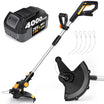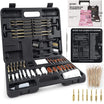As the colder months approach, it's important to ensure that your garden tools are well-prepared for winter. Proper maintenance and winterization of your tools can significantly extend their lifespan, saving you money and making spring gardening easier. In this guide, we'll walk you through the essential steps to protect and preserve your garden tools during the off-season.
Why Winterizing Your Garden Tools Is Important
Garden tools are an investment. Just like any other tool, they require regular care to perform effectively. Rust, dull blades, and broken handles can make gardening difficult and even unsafe. By taking the time to winterize your tools, you not only protect them from rust and wear but also ensure they're ready to use when spring arrives.
Step-by-Step Guide to Winterizing Your Garden Tools
Step 1: Clean Your Tools Thoroughly
Start by cleaning your tools to remove dirt, sap, and other debris that may have accumulated during the growing season. Use a stiff brush or a wire scrubber to remove any stubborn soil. For sap and sticky residue, use a cloth soaked in soapy water or mineral spirits to clean the blades.
- Rinse with Water: For basic cleaning, rinse your tools with a hose or in a bucket of water.
- Use Soap for Stubborn Dirt: For more persistent grime, add a little dish soap to warm water and scrub the tools with a brush.
- Dry Completely: After cleaning, dry each tool thoroughly with a towel to prevent rust formation.
Step 2: Sharpen Blades and Edges
Sharp tools not only make gardening easier but also protect plants from damage. Blunt blades can tear plant tissue, making them more susceptible to disease. Use a sharpening stone, file, or grinder to sharpen the edges of pruning shears, shovels, hoes, and other bladed tools.
- Pruning Shears and Loppers: Use a fine file to sharpen the cutting edge.
- Shovels and Hoes: Use a coarse file to sharpen the edges for easier digging.
- Test for Sharpness: After sharpening, test the tool by cutting a piece of paper or slicing through soil. The sharper the blade, the easier your gardening tasks will be in spring.
Step 3: Lubricate Moving Parts
Lubricating the moving parts of your tools prevents rust, reduces friction, and ensures smooth operation. This step is particularly important for tools with hinges, such as pruners, shears, and loppers.
- Use WD-40 or Machine Oil: Apply a few drops to moving parts and work them back and forth to distribute the oil evenly.
- Wipe Off Excess: After lubricating, wipe off any excess oil to prevent it from attracting dust and dirt.
Step 4: Protect Wooden Handles
Wooden handles are prone to cracking and splintering, especially in cold, dry conditions. To protect the wood, apply a thin coat of linseed oil or mineral oil.
- Sand Rough Areas: Before applying oil, lightly sand any rough spots to create a smooth surface.
- Apply Oil: Use a cloth to apply the oil, rubbing it into the wood until it's absorbed.
- Let It Dry: Allow the handle to dry completely before storing.
Step 5: Store Tools Properly
Proper storage is key to protecting your tools during the winter months. Store your tools in a dry, covered space like a shed or garage.
- Hang Tools: Hang tools on a wall or use a pegboard to prevent moisture accumulation.
- Avoid Storing on Concrete Floors: The concrete can draw moisture and cause rusting.
- Use a Tool Rack: A tool rack keeps your tools organized and off the ground.
Additional Tips for Maintaining Garden Tools in Winter
- Check for Damaged Parts: Inspect handles, blades, and moving parts for damage. Replace worn-out parts to ensure safety and efficiency in the spring.
- Rust Prevention: If you notice rust spots, use steel wool or sandpaper to remove them. Apply a rust-preventive spray or a coat of mineral oil to prevent further rusting.
- Inspect Power Tools: If you have power tools like hedge trimmers or chainsaws, make sure to drain the fuel and store them in a dry place. Check cords and batteries for wear.
Why Regular Maintenance Matters
Winterizing your garden tools is more than just a seasonal task; it’s a crucial part of regular tool maintenance. Well-maintained tools are safer to use, perform better, and last longer. Plus, starting the spring season with clean, sharp, and rust-free tools makes gardening more enjoyable and less of a hassle.
By following these simple winterization steps, you ensure your tools remain in top condition for years to come, making your investment worthwhile.























Leave a comment
All comments are moderated before being published.
This site is protected by hCaptcha and the hCaptcha Privacy Policy and Terms of Service apply.